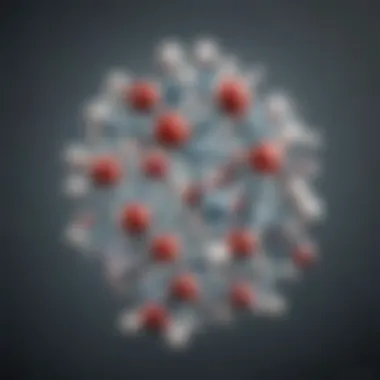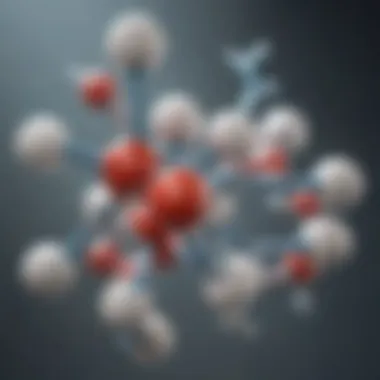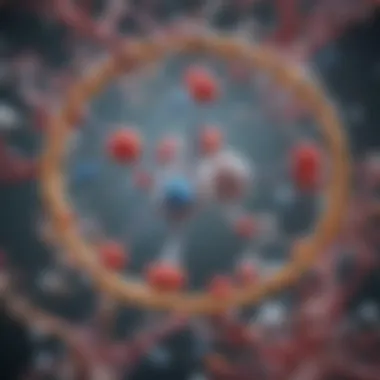N-Acetylcysteine and Glutathione: A Comprehensive Review


Intro
N-acetylcysteine (NAC) and glutathione are two critical molecules in biochemical processes. They are often discussed in the context of cellular health, detoxification, and disease prevention. Understanding their relationship helps to illuminate their roles in maintaining physiological balance and promoting overall health. A key goal of this article is to present a detailed examination of these compounds, breaking them down into their fundamental roles and exploring their therapeutic potentials.
While NAC is a derivative of the amino acid cysteine, glutathione is a tripeptide composed of cysteine, glutamate, and glycine. Both serve important biochemical functions, but they also possess unique characteristics. This piece will delve into their mechanisms of action, how they interact within the body, and their clinical applications.
An important aspect of this exploration involves discussing the physiological and pathological contexts in which these molecules operate. By analyzing their significance in various health conditions, we can appreciate the complexity and importance of NAC and glutathione in both preventive and therapeutic frameworks.
Understanding N-Acetylcysteine
N-Acetylcysteine, commonly referred to as NAC, is more than just a supplement; it is a compound that plays multiple roles in our body. Understanding NAC is crucial for comprehending its benefits and potential applications in medical and health contexts. As a precursor to glutathione, one of the most vital antioxidants in our body, NAC's importance cannot be overstated.
In addition to being an antioxidant, NAC is known for its mucolytic properties. This means it can help break down mucus, making it especially beneficial for individuals with respiratory conditions. Furthermore, NAC has been studied for its role in mental health, demonstrating potential in treating conditions such as depression and bipolar disorder.
Chemical Composition and Properties
NAC is a modified form of the amino acid cysteine. This chemical modification enhances its stability and increases its bioavailability when consumed. The molecular formula of NAC is C5H9NO3S. It is soluble in water, allowing for easy absorption in the gastrointestinal tract. This property makes it a popular choice in various therapies.
NAC has a thiol group, which is reactive and contributes to its antioxidant capabilities. This group allows NAC to donate electrons, neutralizing free radicals that can lead to oxidative stress. This mechanism of action is central to NAC's health benefits, making it an important compound in both preventive and therapeutic medicine.
Mechanism of Action in the Body
Understanding how NAC works in the body helps to appreciate its diverse applications. NAC's primary role is as a precursor to glutathione, facilitating its synthesis. Glutathione plays a critical role in cellular protection against oxidative damage. When we consume NAC, it is metabolized into cysteine, which is then used for glutathione production. This process is essential for maintaining cellular health and function.
Moreover, NAC acts on the respiratory system by thinning mucus, which enhances lung function and eases breathing in people with chronic respiratory diseases. It is also known to modulate neurotransmitter systems, which suggests it might help in managing mood disorders.
Historical Context and Development
The development of NAC can be traced back several decades. Originally synthesized in 1960, it was used as a mucolytic agent in the treatment of chronic obstructive pulmonary disease. Since then, research has expanded its applications, revealing its potential in various pathophysiological conditions. The FDA has approved NAC for specific uses, such as treating acetaminophen overdose, which highlights its critical role in medical treatments.
Throughout the years, as awareness of oxidative stress and its effects on health grew, so did the research around NAC. Today, it is commonly available as a dietary supplement, drawing interest for its antioxidant properties and benefits in mental health and chronic diseases. Its dual role as an antioxidant and mucolytic continues to be an area of active research, providing numerous avenues for further exploration.
The Role of Glutathione in Cellular Function
Glutathione is often termed as the body's master antioxidant. Its significance in cellular function cannot be overstated. This tripeptide, composed of glutamine, cysteine, and glycine, performs various roles that are crucial for maintaining cellular health. It is involved in detoxification, oxidative stress response, and the modulation of various cellular processes.
Glutathione exists in two forms: reduced (GSH) and oxidized (GSSG). The reduced form functions actively as an antioxidant, while the oxidized form acts as a reservoir, indicating the oxidative status of a cell. The ratio of these two forms is an important marker for cellular redox status. When the level of GSH is high, the cell is considered to be in a reduced state, promoting optimal cellular functions.
Structure and Function of Glutathione
The structure of glutathione allows it to perform its functions efficiently. The peptide bond formed between cysteine and glutamate provides a reactive thiol group. This thiol group is what makes glutathione an exceptional antioxidant. It can donate electrons to neutralize reactive oxygen species (ROS), which are produced during metabolic processes. By doing so, glutathione helps prevent oxidative damage to proteins, lipids, and DNA, thus preserving cellular integrity.
In addition to its role as an antioxidant, glutathione also participates in detoxifying harmful compounds in the liver. It conjugates to drugs, heavy metals, and various reactive metabolites, making them less toxic and easier for the body to excrete. This detoxification process is vital for overall health, especially for those exposed to environmental toxins and pollutants.


Antioxidant Properties of Glutathione
Glutathione exhibits potent antioxidant properties, enabling it to scavenge free radicals and prevent cellular damage. Free radicals are unstable molecules that can initiate chain reactions of oxidative stress, leading to cell injury and apoptosis. Glutathione intervenes by neutralizing these radicals, thereby reducing the risk of chronic diseases linked to oxidative stress, such as cancer and heart disease.
Moreover, glutathione plays a role in regenerating other antioxidants, such as vitamins C and E. By maintaining the levels of these vitamins, glutathione enhances the body’s overall antioxidant capacity, providing a multi-layered defense against oxidative damage.
Glutathione and Free Radical Scavenging
The ability of glutathione to scavenge free radicals is pivotal in preventing oxidative stress. It does so through a reaction mechanism that involves the formation of a mixed disulfide bond with reactive species. This process not only neutralizes free radicals but also transforms them into stable molecules.
Glutathione's involvement in free radical scavenging is particularly important in high-energy organs like the brain and heart. These regions are susceptible to oxidative damage due to their high oxygen consumption and metabolic activity. The maintenance of adequate glutathione levels in these areas is essential for cellular resilience.
"Glutathione is not just an antioxidant; it is fundamental in maintaining cellular redox balance and biochemical stability."
In summary, glutathione functions as a critical protector in cellular processes, highlighting its importance in health and disease. Its unique structure and multifaceted roles, primarily as an antioxidant, make it indispensable in sustaining cellular function efficiently.
Interconnection Between NAC and Glutathione
The relationship between N-acetylcysteine (NAC) and glutathione is essential for understanding their roles in human health. NAC is widely recognized as a critical precursor to glutathione, the body’s most vital antioxidant. This section will delve into the interconnectedness of these two compounds, detailing how they work synergistically to support cellular function and maintain overall health.
NAC delivers cysteine, a building block necessary for the synthesis of glutathione. This is particularly important because cysteine is often the limiting factor in glutathione production. In conditions where the body experiences oxidative stress, the demand for glutathione rises. By supplementing with NAC, individuals can potentially enhance their glutathione levels, thus boosting the body’s defense mechanisms.
NAC as a Precursor to Glutathione
NAC serves as a precursor to glutathione by elevating cysteine levels in the body. Cysteine, along with glutamate and glycine, forms the tripeptide structure of glutathione. The conversion from cysteine to glutathione occurs in two key steps. First, cysteine is combined with glutamate to form gamma-glutamylcysteine. Next, glycine is added to create glutathione. This process is facilitated by several enzymes, including gamma-glutamylcysteine synthetase and glutathione synthetase.
The availability of cysteine can be particularly critical during times of increased oxidative stress. Illness, pollution, and toxins can deplete glutathione reserves. By increasing the intake of NAC, individuals may enhance their capacity to synthesize glutathione, thereby supporting their antioxidant defenses.
Biochemical Pathway of Glutathione Synthesis
The synthesis of glutathione involves a specific biochemical pathway that underscores its importance in cellular defense. This pathway occurs primarily in the liver and kidney and involves the sequential action of two enzymes. The first step, catalyzed by gamma-glutamylcysteine synthetase, combines cysteine and glutamate to produce gamma-glutamylcysteine. This step is pivotal and tightly regulated, as it can influence the overall synthesis of glutathione.
In the second step, glutathione synthetase incorporates glycine into gamma-glutamylcysteine, resulting in the formation of glutathione. The pathway integrates various nutrients, including vitamin C and selenium, which may also assist in maintaining adequate levels of glutathione. This intricate interplay highlights how nutritional status and supplementation can directly influence glutathione levels within the body.
Effects of NAC Supplementation on Glutathione Levels
Research suggests that NAC supplementation can significantly elevate glutathione levels in various contexts. Clinical studies have indicated that individuals with chronic conditions, such as chronic obstructive pulmonary disease (COPD) or liver disorders, often see improvement in glutathione levels following NAC therapy. By supplying the necessary cysteine, NAC enables the body to combat oxidative stress more effectively.
Some studies have shown that NAC can increase glutathione levels by 30% to 50% within a short duration. However, the effect can vary based on individual factors, including age, health status, and the presence of other co-factors. Therefore, while NAC represents a promising route for enhancing glutathione synthesis, it is vital for individuals to consult healthcare providers for tailored recommendations.
NAC, via its role as a precursor to glutathione, plays an integral part in enhancing the body’s antioxidant capacity and reducing oxidative damage.
The interconnection of NAC and glutathione illustrates a fundamental aspect of cellular biology, elucidating the therapeutic potential these compounds possess. By understanding how NAC boosts glutathione production, we can appreciate its implications for various health conditions and overall wellness.


Therapeutic Applications of NAC and Glutathione
The therapeutic applications of N-acetylcysteine (NAC) and glutathione are vital in understanding their roles in health and medicine. Both compounds have shown promise in treating a variety of conditions, offering potential benefits that extend to numerous bodily systems. By exploring these applications, we can appreciate their significance and the potential impact on patient care and clinical outcomes.
Respiratory Conditions and NAC Therapy
N-acetylcysteine is primarily known for its mucolytic properties, which means it helps break down mucus. This property makes NAC an essential component in treating respiratory diseases such as chronic obstructive pulmonary disease (COPD) and cystic fibrosis. By thinning mucus, NAC facilitates easier breathing and enhances lung function. In addition, it has been used in cases of acetaminophen overdose to replenish glutathione levels in the liver, thereby mitigating toxicity.
Studies indicate that administering NAC can improve lung function and reduce the frequency of exacerbations in chronic lung conditions. Patients report a better quality of life due to improved symptoms. While NAC is generally well tolerated, ongoing research aims to establish optimal dosages and long-term effects in various populations suffering from respiratory ailments.
NAC in Mental Health Treatment
The potential of NAC in the mental health field is noteworthy. Preliminary research suggests that NAC may help in conditions like depression, bipolar disorder, and obsessive-compulsive disorder (OCD). The compound's role as a glutathione precursor could underlie its benefits by reducing oxidative stress, which is implicated in various mental health disorders.
Clinical trials have observed significant reductions in symptoms when patients with mood disorders are supplemented with NAC. The antioxidant properties of NAC may aid in normalizing glutamate levels, a neurotransmitter associated with mood regulation. Larger studies are needed to solidify these findings, but the existing evidence hints at NAC being a valuable adjunct therapy.
The Role of Glutathione in Detoxification
Glutathione is recognized as a critical player in detoxification processes within the body. It exists primarily in cells and assists in neutralizing free radicals and reacting with potentially harmful substances. Through conjugation, glutathione modifies various toxins, allowing for their elimination through the bile or urine.
The liver, being the hub of detoxification, heavily relies on adequate glutathione levels. A decrease in glutathione may lead to heightened toxic accumulation, raising questions about cellular stress and susceptibility to disease. Enhancing glutathione can occur through lifestyle changes or supplementation, making it vital in various detoxification protocols.
Glutathione is often referred to as the body's master antioxidant due to its unique ability to combat free radicals and support immune function.
Potential Anti-Aging Effects of Glutathione
The search for anti-aging interventions has led to increased interest in glutathione. As we age, glutathione levels decline, which correlates with an increase in oxidative stress and the risk for age-related diseases. This decline has sparked research into whether restoring or boosting glutathione levels can influence aging and longevity.
Studies have shown that higher glutathione levels can improve skin elasticity and reduce the appearance of wrinkles. The potential cognitive benefits are also under investigation, as maintaining adequate glutathione may protect neurons from age-related degeneration. Although there are optimistic indicators, more robust long-term studies are required to fully understand glutathione's role in the aging process.
Clinical Considerations
Understanding the clinical considerations surrounding N-acetylcysteine (NAC) and glutathione is critical for both practitioners and patients. This section addresses important elements such as recommended dosages, safety profiles, and potential drug interactions. These considerations are vital for maximizing therapeutic benefits while minimizing risks associated with these compounds.
Recommended Dosages for NAC and Glutathione
The appropriate dosage of NAC and glutathione can depend on various factors including age, health status, and the specific condition being treated. For adults, typical dosages for NAC may range from 600 mg to 1,800 mg per day, depending on the therapeutic goal. In certain cases, such as cystic fibrosis or chronic obstructive pulmonary disease (COPD), higher doses may be warranted under medical supervision.
On the other hand, glutathione is not always available as a direct supplement; it may be taken in precursors such as NAC itself or in combination products. When considering glutathione supplements, common doses range from 250 mg to 1,000 mg daily.
It is essential for individuals to consult healthcare providers to personalize dosages based on their unique medical circumstances. Overconsumption can lead to adverse effects, outlining the need for tailored recommendations.
Safety and Side Effects


Both NAC and glutathione are generally considered safe when used appropriately. However, it is still important to recognize potential side effects. NAC, while well tolerated, may cause nausea, vomiting, or gastrointestinal upset in some individuals. Rarely, it could lead to an allergic reaction, necessitating immediate medical assessment.
Glutathione supplementation can also present risks. Some reported side effects include abdominal cramps and allergic reactions. Experts suggest using glutathione cautiously in individuals with asthma, as it may exacerbate symptoms in certain cases.
"While NAC and glutathione offer potential health benefits, awareness of side effects is vital for safe usage."
Interactions with Other Medications
When counseling patients regarding NAC and glutathione, awareness of drug interactions is paramount. NAC can interact with various medications, including nitroglycerin. It may enhance the effects of this drug, which could lead to increased side effects such as dizziness or low blood pressure.
Conversely, glutathione may also interact with certain chemotherapeutic agents by altering their effectiveness or toxicity. For example, some studies suggest that glutathione may impact the metabolism of medications like doxorubicin, requiring careful monitoring by healthcare professionals.
Patients should always inform their doctors of any supplements they are taking to avoid unintended interactions. This precaution is crucial for ensuring safe and effective treatment plans.
Future Directions in Research
The exploration of N-acetylcysteine (NAC) and glutathione continues to uncover various potential applications and therapeutic avenues. Research in this area is essential for advancing our understanding of these compounds and can lead to significant health benefits. Future studies may focus on addressing gaps in knowledge, particularly related to the effectiveness, mechanisms of action, and optimal usage of NAC and glutathione.
Potential New Therapeutic Areas
One of the most intriguing aspects of NAC and glutathione research is their potential application in new therapeutic areas. Recent studies suggest roles in conditions beyond the commonly associated diseases. For instance, potential benefits in metabolic disorders and neurodegenerative diseases are being investigated.
- Metabolic Disorders: The ability of NAC to influence insulin sensitivity through glutathione elevation offers a prospective approach to manage diabetes.
- Neurodegenerative Diseases: Preliminary findings indicate that NAC could have protective effects on neuronal health, presenting potential strategies for treating conditions like Alzheimer's and Parkinson’s.
- Chronic Inflammation: Research could also explore how NAC’s anti-inflammatory properties might mitigate chronic inflammatory conditions.
Advancements in Delivery Methods
The efficacy of NAC and glutathione can be significantly influenced by their route of delivery. Current research is examining the development of new delivery methods to enhance absorption and therapeutic effect.
- Liposomal Delivery: Encapsulating NAC in liposomes may improve its bioavailability and reduce gastrointestinal side effects.
- Intravenous Administration: For acute conditions, IV delivery of NAC is already in use, but further studies can optimize its application in various settings.
- Nanotechnology: Application of nanocarriers for targeted drug delivery is a forward-looking area that could improve the efficacy of glutathione supplementation.
Longitudinal Studies on Efficacy
To establish the long-term benefits and safety of NAC and glutathione supplementation, longitudinal studies are critical. Such studies should focus on evaluating the sustained impact on biomarkers, health outcomes, and overall quality of life.
- Health Outcomes: Monitoring a diverse group of participants over extended periods can provide insights into the preventive aspects of NAC and glutathione.
- Quality of Life Assessments: Utilizing validated tools to track improvements in daily functioning and wellbeing can substantiate claims of efficacy.
- Side Effects Over Time: Understanding the long-term safety profile is fundamental, as chronic use can reveal previously unnoticed side effects.
Research directed toward NAC and glutathione will open avenues for innovative treatments. A multi-faceted approach combining new therapeutic areas, improved delivery methods, and robust longitudinal studies will inevitably pave the way for unlocking their full potential.
Summary and Culmination
In the exploration of N-Acetylcysteine (NAC) and glutathione, we uncover pivotal connections in biochemistry and their broad implications in health. This section encapsulates crucial insights from prior sections. Understanding NAC and glutathione is fundamental for both clinical applications and individual health benefits. Recognizing their roles in antioxidant defense and detoxification mechanisms enhances the value of this knowledge for researchers and practitioners.
Furthermore, the therapeutic potential of NAC deserves attention, especially for respiratory diseases and mental health conditions. It acts as a precursor for glutathione, thus amplifying its importance and efficacy. When considering clinical applications, grasping the nuances of dosing and safety cannot be overstated. The growing body of evidence supporting these compounds shapes future therapeutic interventions.
Recap of Key Points
- NAC and glutathione are significant in cellular function and health.
- NAC serves as a precursor, crucial for enhancing glutathione levels.
- These compounds have therapeutic roles in respiratory conditions, mental health treatments, and detoxification processes.
- Understanding dosing, safety, and possible interactions is essential for effective use.
- Current and future research into these areas promises advancements in healthcare.
Final Thoughts on NAC and Glutathione
The relationship between NAC and glutathione illustrates an intricate network vital for maintaining cellular health. As research evolves, it will be critical to refine our understanding and utilization of these molecules. Professionals in science and healthcare stand to benefit from ongoing studies and clinical observations. The potential for both NAC and glutathione in therapeutics is vast, yet it requires careful consideration of individual patient needs and responses. Their roles in combating oxidative stress and supporting vital bodily functions should not be underestimated.



